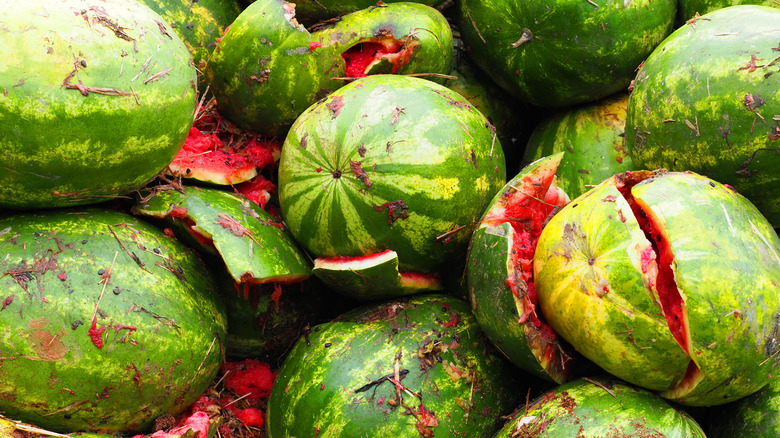When Your Watermelon Fizzes And Hisses, It's Too Late
There's nothing as refreshing on a hot day as a slice of cold, juicy watermelon. Some may say it's hard to tell when the fruit is ripe, but you're not worried. You've mastered the "thump" test, know that the melon's ground spot should be yellow (not white), and that the tiny black and brown sugar spots on the rind are indicators of a gloriously ripe fruit.
Armed with this knowledge, you head out to the grocery store or farmers market to pick what you're sure will be the most magnificent watermelon you've ever tasted. After finding a fruit that meets your criteria and taking it home to enjoy, it's time to start thinking of all the tasty dishes you can make with it, like watermelon gazpacho or even some delicious watermelon granita.
Yet, after washing the fruit off and grabbing your largest knife and cutting board to dismember the melon, you're met with white foam fizzing out of it. What's going on? Is the watermelon just excited to see you? Is it still safe to eat?
Nope. You just cut into a rotten watermelon, and the fizzing and hissing you saw and heard are clear indicators that it's too far gone. You can just toss it into the garbage and try again.
When good watermelons go bad
So, why do watermelons get all dramatic when they rot? It's all because of fermentation. This chemical process is where bacteria and other microorganisms such as yeast feed on a substance's sugar molecules. The munching microorganisms produce carbon dioxide gas, which makes the food expand. This is why bread dough rises, and beer is frothy and effervescent.
In the case of watermelon, the pulp is filled with water of course, but also fructose, glucose, and sucrose — three ready-to-ferment sugars that look like a mouthwatering buffet for bacteria with a sweet tooth, according to a study published by the American Journal of Research Communication.
So, if a microorganism happens to somehow sneak through the rind — maybe the surface was accidentally pricked with something sharp or an animal attempted to gnaw on it — those tiny bacteria can start feasting on the watermelon's innards, which starts the fermentation process and begins to rot the fruit.
Because watermelon rinds are thick, there's no way for the expanding CO2 to escape on their own. This is why you'll see and hear the obnoxious fizzling foam spew out of the rotten melon when attempting to cut it.
Don't eat rotten watermelon
While not all foods have to be tossed at the first signs of rot (you can eat moldy cheese, and trim the bad spots off certain fruits and vegetables), it's highly recommended that you do not eat watermelon past its prime. As stated earlier, the fruit's inner pulp is the ideal environment for bacterial growth. Though you may be thinking that, since fermentation is involved, the only microorganisms sitting around the fruit would be the safe-to-eat yeast, that's not always the case.
Depending on the environment that the watermelon is grown in, the rind can play host to any number of germs like E-coli and salmonella, states a Michigan State University Extension article. These dangerous pathogens are extremely hazardous if consumed, and can lead to intense illness involving extra time in bed and the bathroom (or even a trip to the hospital), says the CDC.
The smartest and safest thing to do when you encounter a foaming, fizzing, and hissing watermelon is to get take it straight to the garbage can and look for a new prized fruit.



